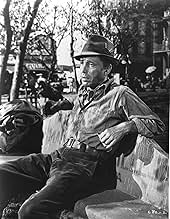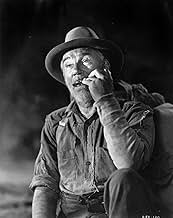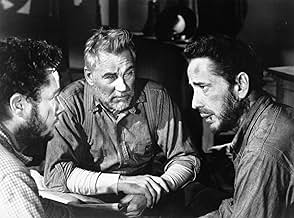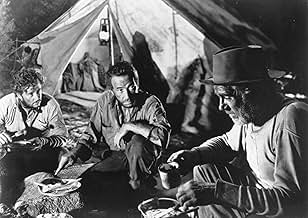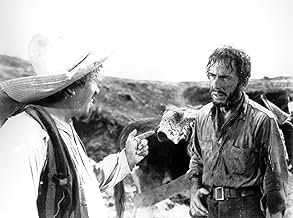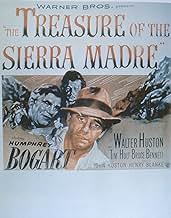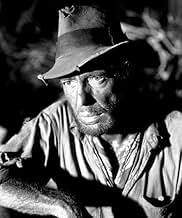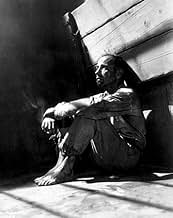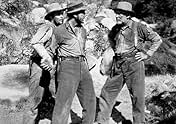Dos norteamericanos en México convencen a un hombre para que los ayude a extraer oro en las montañas de Sierra Madre.Dos norteamericanos en México convencen a un hombre para que los ayude a extraer oro en las montañas de Sierra Madre.Dos norteamericanos en México convencen a un hombre para que los ayude a extraer oro en las montañas de Sierra Madre.
- Ganó 3 premios Óscar
- 18 premios ganados y 5 nominaciones en total
Barton MacLane
- Pat McCormick
- (as Barton Mac Lane)
Arturo Soto Rangel
- Presidente
- (as A. Soto Rangel)
Manuel Dondé
- El Jefe
- (as Manuel Donde)
José Torvay
- Pablo
- (as Jose Torvay)
Robert Blake
- Mexican Boy Selling Lottery Tickets
- (sin créditos)
Guillermo Calles
- Mexican Storeowner
- (sin créditos)
Roberto Cañedo
- Mexican Lieutenant
- (sin créditos)
Spencer Chan
- Proprietor
- (sin créditos)
Jacqueline Dalya
- Flashy Girl
- (sin créditos)
Ralph Dunn
- Flophouse Bum
- (sin créditos)
Ernesto Escoto
- Mexican Bandit
- (sin créditos)
- Dirección
- Escritura
- Todo el elenco y el equipo
- Producción, taquilla y más en IMDbPro
8.2139.7K
1
2
3
4
5
6
7
8
9
10
Resumen
Reviewers say 'The Treasure of the Sierra Madre' is a critically acclaimed classic, lauded for its profound examination of greed, betrayal, and human nature. John Huston's direction and screenplay, alongside exceptional performances by Humphrey Bogart, Walter Huston, and Tim Holt, are often celebrated. The film's authentic atmosphere, intricate character studies, and moral complexities deeply resonate. Although some critique its pacing and subplots, most regard it as a timeless masterpiece noted for its psychological depth and thematic richness.
Opiniones destacadas
A treasure presented to the viewer
Some movies have certain scenes in them that hold the viewers interest more than others. However every single scene in this film holds the viewers interest. There is never a dull or lagging moment. Three down and outers who at one time in their lives were maybe up and comers strike out in search of a fortune or at least enough to live better than they have been.
While Humphrey Bogart gives a superb performance it is Walter Huston who turns in the greatest performance as the old prospector Howard. The scene in the Indian village where he helps to restore a comatose child is one of the most touching in all of film history and is done virtually without any dialog. Mexican character actor Alfonso Bedoya of course steals all the scenes he appears in and delivers his classic "Stinking Badges" line. (what person would dress up as a Bandito for a costume party and not want to look exactly like Bedoya's Gold Hat character?) This film probably should have been a little higher on AFI's top 100. A must see!
While Humphrey Bogart gives a superb performance it is Walter Huston who turns in the greatest performance as the old prospector Howard. The scene in the Indian village where he helps to restore a comatose child is one of the most touching in all of film history and is done virtually without any dialog. Mexican character actor Alfonso Bedoya of course steals all the scenes he appears in and delivers his classic "Stinking Badges" line. (what person would dress up as a Bandito for a costume party and not want to look exactly like Bedoya's Gold Hat character?) This film probably should have been a little higher on AFI's top 100. A must see!
Bogart and the Stinking Badges
Two penniless Americans (Humphrey Bogart and Tim Holt) during the 1920s in Mexico join with an old-timer (Walter Huston, the director's father) to prospect for gold. The old-timer accurately predicts trouble, but is willing to go anyway. The film is fictional, but presents a very realistic scenario: By the 1920s the violence of the Mexican Revolution had largely subsided, although scattered gangs of bandits continued to terrorize the countryside. The newly established post-revolution government relied on the effective, but ruthless, Federal Police, commonly known as the Federales, to patrol remote areas and dispose of the bandits. Foreigners, like the three American prospectors, were at very real risk of being killed by the bandits if their paths crossed. The bandits, likewise, were given little more than a "last cigarette" by the army units after capture, even having to dig their own graves first.
The film shows the Americans doing just about anything for money: drilling oil, digging for gold, begging and more. And once gold comes into the picture, the men who once claimed they were not greedy see things differently. Bogart actually goes mad, after he gets greedy and paranoid... during which he encounters a gila monster! The most memorable scene of this film involves the bandits, who don't need any "stinking badges". While the line is much more quotable in "Blazing Saddles", we couldn't have "Blazing Saddles" (or "UHF") without this film... just about everyone, even those who never saw or heard of "Sierra Madre", knows the badges line.
Humphrey Bogart's best film is probably "Casablanca", but this one features him in a nice, rough exterior. Yes, sometimes leading men have beards and are covered in dirt. Pretty boys do not stay pretty boys after digging in the hills, or at least that wouldn't be realistic. This film does a fine job trying to "keep it real", so we have to commend Huston not only on his directing, but his wonderful location scouting.
The film shows the Americans doing just about anything for money: drilling oil, digging for gold, begging and more. And once gold comes into the picture, the men who once claimed they were not greedy see things differently. Bogart actually goes mad, after he gets greedy and paranoid... during which he encounters a gila monster! The most memorable scene of this film involves the bandits, who don't need any "stinking badges". While the line is much more quotable in "Blazing Saddles", we couldn't have "Blazing Saddles" (or "UHF") without this film... just about everyone, even those who never saw or heard of "Sierra Madre", knows the badges line.
Humphrey Bogart's best film is probably "Casablanca", but this one features him in a nice, rough exterior. Yes, sometimes leading men have beards and are covered in dirt. Pretty boys do not stay pretty boys after digging in the hills, or at least that wouldn't be realistic. This film does a fine job trying to "keep it real", so we have to commend Huston not only on his directing, but his wonderful location scouting.
Just a great movie all around, but a very dark tale
This film is a sharp-edged study of the effects of greed on otherwise normal men, and one man in particular: Bogart's Fred C. Dobbs. Dobbs and Bob Curtin (Tim Holt) are down and out and meet up with prospector Howard (Walter Huston). When Dobbs wins a lottery, he uses the proceeds to finance a trip for the three to central Mexico to search for gold.
The three have to deal with the lawlessness of central Mexico at the time - bandits were actually on the loose in that country killing anybody with stuff, and taking that stuff. The Federales were a violent solution to a violent problem - killing the bandits after a summary judgement and the bandits having dug their own graves. So our trio not only have to worry about bandits once they strike gold, they have to worry about the darkness of their own souls.
In the beginning, Bogart's Fred C. Dobbs is a decent guy who does not take advantage of others. Dobbs only takes his money from the guy that wouldn't pay and he does share his lottery ticket and is generous with his fellow miners, but as greed begins to take root in him, little by little we see his goodness eaten away. It's a great credit to the writing and Bogart's skills that this is done gradually and played out over time. Incidentally, that's director John Huston "staking him to a meal". One of the best director cameos ever (although Polanski in Chinatown is equally great)!
Dobbs overestimates himself and the fallibility of human nature. Walter Hustons character freely admits what gold could do to any of them including himself. Dobbs is sure it will never happen to him, but he's never had anything, so he's never faced temptation, and when he falls it's a long way down.
This may be Tim Holt's finest performance - it was probably his finest opportunity given he had spent years laboring as a B western star on the RKO lot. Walter Huston as the prospector, minus his dentures and plus a bunch of pounds and with holes in his clothes is not the debonair fellow you are used to seeing in film . If Mary Astor's character in Dodsworth could have thought this was the future appearance of the man she loved, would she have taken her gondola in the other direction? I guess we'll never know.
Highly recommended as one of the great character studies in which several characters get studied in detail.
The three have to deal with the lawlessness of central Mexico at the time - bandits were actually on the loose in that country killing anybody with stuff, and taking that stuff. The Federales were a violent solution to a violent problem - killing the bandits after a summary judgement and the bandits having dug their own graves. So our trio not only have to worry about bandits once they strike gold, they have to worry about the darkness of their own souls.
In the beginning, Bogart's Fred C. Dobbs is a decent guy who does not take advantage of others. Dobbs only takes his money from the guy that wouldn't pay and he does share his lottery ticket and is generous with his fellow miners, but as greed begins to take root in him, little by little we see his goodness eaten away. It's a great credit to the writing and Bogart's skills that this is done gradually and played out over time. Incidentally, that's director John Huston "staking him to a meal". One of the best director cameos ever (although Polanski in Chinatown is equally great)!
Dobbs overestimates himself and the fallibility of human nature. Walter Hustons character freely admits what gold could do to any of them including himself. Dobbs is sure it will never happen to him, but he's never had anything, so he's never faced temptation, and when he falls it's a long way down.
This may be Tim Holt's finest performance - it was probably his finest opportunity given he had spent years laboring as a B western star on the RKO lot. Walter Huston as the prospector, minus his dentures and plus a bunch of pounds and with holes in his clothes is not the debonair fellow you are used to seeing in film . If Mary Astor's character in Dodsworth could have thought this was the future appearance of the man she loved, would she have taken her gondola in the other direction? I guess we'll never know.
Highly recommended as one of the great character studies in which several characters get studied in detail.
Truly something special
This film made a huge impression on me when I first saw it at the age of 15 or 16. A recent rewatching on DVD really served to bring home for me what makes this film so special.
The whole thing is quite good, but it really hits you when Howard goes off to celebrate with the Indians, leaving Dobbs and Curtin to care for his gold and burros. The ensuing scenes of their spiraling mistrust and tension are absolutely spellbinding--the kind of thing that makes you lean forward in your seat just to get your eyes a little closer to the raw humanity unfolding in front of you. Their paranoia, the way you can SEE scenarios of betrayal dancing in their eyes, Dobbs' burgeoning madness--these are the moments that make this film one for the ages.
At its best, film noir (which this most certainly is--Western surroundings or no) makes the viewer complicit in the evil depicted on screen. We find ourselves scheming and plotting in our heads along with the unsavory characters we are watching--we start to feel the same temptations and desires that they do. "Treasure of the Sierra Madre" accomplishes this bond with the audience as well as any film you are likely to see.
A magnificent film--one of the few great screen tragedies.
The whole thing is quite good, but it really hits you when Howard goes off to celebrate with the Indians, leaving Dobbs and Curtin to care for his gold and burros. The ensuing scenes of their spiraling mistrust and tension are absolutely spellbinding--the kind of thing that makes you lean forward in your seat just to get your eyes a little closer to the raw humanity unfolding in front of you. Their paranoia, the way you can SEE scenarios of betrayal dancing in their eyes, Dobbs' burgeoning madness--these are the moments that make this film one for the ages.
At its best, film noir (which this most certainly is--Western surroundings or no) makes the viewer complicit in the evil depicted on screen. We find ourselves scheming and plotting in our heads along with the unsavory characters we are watching--we start to feel the same temptations and desires that they do. "Treasure of the Sierra Madre" accomplishes this bond with the audience as well as any film you are likely to see.
A magnificent film--one of the few great screen tragedies.
Still vivid, compact, colorful, and intense, with some acting to, uh, die for.
The Treasure of the Sierra Madre (1948)
This is a weirdly contemporary film. I mean, it's certainly set in the past, and it's made in the heyday of Hollywood genius top to bottom which is long gone. But because it's about this old time and about raw black and white issues (often), the film and the filming are really appropriate. The whole thing just fits, and beautifully.
And I mean beautiful. As rugged as it all is--the landscape as well as the beards, all very real--the movie is lyrically filmed. The story is told with visual clarity. And the script, speaking of story, is sophisticated and believable. In all, under the direction of legend John Huston, this is a spot on terrific movie.
Of course, there are two actors who are just amazing in their roles (and a third, Tim Holt, who is just fine, if not stellar). I mean of course Walter Huston, who nearly steals the show in every scene. He's a character, but not a caricature. His wisdom--real wisdom, based on smart observation over decades of experience--is sterling. Great stuff, well put. And of course he's the father of the director, which is a fun, and slightly Freudian twist. He gives one of the great performances of the decade.
Humphrey Bogart is not far behind, actually. If you like him in Maltese Falcon or Casablanca, you'll be surprised at first by the scruffy, raw character played here. But it's clear-headed, brilliantly delivered Bogart all the way, and a joy to watch him really act. See it for him, too.
Then there is the story itself, which is as important now as ever. That is, what matters in life? And what is the price to pay to get it? It's all rather bold and emotional even though it's delivered by some rough guys out of money prospecting in the wilderness of Mexico.
Are there downsides here? I suppose. You certainly can wonder about the way the Mexicans--good ones and banditos both--are portrayed. I think it's not bad, tinged with clichés, of course, but in Spanish without translation or stilted half-English, so it's the real thing. And no subtitles. Nicely done for an early Hollywood affair. Huston, the son, the director, if you don't know, is famous for doing things raw and right and slightly off the charts. He is making a commercial film, to be sure, but it has many small aspects that are just not pandering to anyone. This makes it work.
I'm sure to some this is a masterpiece. I'm giving that some thought. See it.
This is a weirdly contemporary film. I mean, it's certainly set in the past, and it's made in the heyday of Hollywood genius top to bottom which is long gone. But because it's about this old time and about raw black and white issues (often), the film and the filming are really appropriate. The whole thing just fits, and beautifully.
And I mean beautiful. As rugged as it all is--the landscape as well as the beards, all very real--the movie is lyrically filmed. The story is told with visual clarity. And the script, speaking of story, is sophisticated and believable. In all, under the direction of legend John Huston, this is a spot on terrific movie.
Of course, there are two actors who are just amazing in their roles (and a third, Tim Holt, who is just fine, if not stellar). I mean of course Walter Huston, who nearly steals the show in every scene. He's a character, but not a caricature. His wisdom--real wisdom, based on smart observation over decades of experience--is sterling. Great stuff, well put. And of course he's the father of the director, which is a fun, and slightly Freudian twist. He gives one of the great performances of the decade.
Humphrey Bogart is not far behind, actually. If you like him in Maltese Falcon or Casablanca, you'll be surprised at first by the scruffy, raw character played here. But it's clear-headed, brilliantly delivered Bogart all the way, and a joy to watch him really act. See it for him, too.
Then there is the story itself, which is as important now as ever. That is, what matters in life? And what is the price to pay to get it? It's all rather bold and emotional even though it's delivered by some rough guys out of money prospecting in the wilderness of Mexico.
Are there downsides here? I suppose. You certainly can wonder about the way the Mexicans--good ones and banditos both--are portrayed. I think it's not bad, tinged with clichés, of course, but in Spanish without translation or stilted half-English, so it's the real thing. And no subtitles. Nicely done for an early Hollywood affair. Huston, the son, the director, if you don't know, is famous for doing things raw and right and slightly off the charts. He is making a commercial film, to be sure, but it has many small aspects that are just not pandering to anyone. This makes it work.
I'm sure to some this is a masterpiece. I'm giving that some thought. See it.
¿Sabías que…?
- TriviaIn his Oscar acceptance speech, Walter Huston said, "Many, many years ago, I brought up a boy and I said to him, 'Son, if you ever become a writer, try to write a good part for your old man sometime'. Well, by cracky, that's what he did!"
- ErroresAlthough set in the 1920s, many of the cars on the streets of Tampico are of 1930s and 1940s vintage; likewise, women, when prominently seen, are groomed and dressed strictly in the style of the 1940s.
- ConexionesFeatured in The Screen Writer (1950)
- Bandas sonorasBelieve Me If All Those Endearing Young Charms
(1808) (uncredited)
Music traditional
Played on harmonica by Walter Huston
Selecciones populares
Inicia sesión para calificar y agrega a la lista de videos para obtener recomendaciones personalizadas
Detalles
- Fecha de lanzamiento
- País de origen
- Idiomas
- También se conoce como
- The Treasure of the Sierra Madre
- Locaciones de filmación
- Kernville, California, Estados Unidos(Kelly's Rainbow Mine)
- Productora
- Ver más créditos de la compañía en IMDbPro
Taquilla
- Presupuesto
- USD 3,000,000 (estimado)
- Total en EE. UU. y Canadá
- USD 5,014,000
- Fin de semana de estreno en EE. UU. y Canadá
- USD 144,074
- 14 ene 2018
- Total a nivel mundial
- USD 5,014,124
- Tiempo de ejecución
- 2h 6min(126 min)
- Color
- Relación de aspecto
- 1.37 : 1
Contribuir a esta página
Sugiere una edición o agrega el contenido que falta


